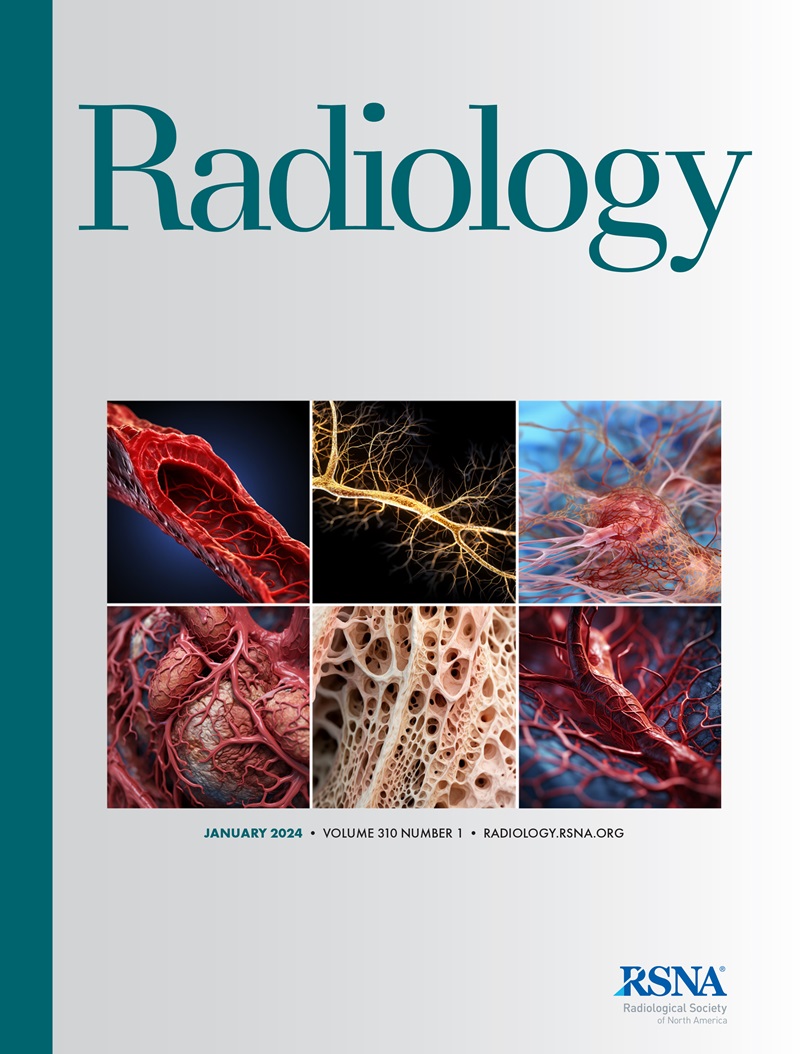Tatjana Dell, Narine Mesropyan, Yannik Layer, Verena Tischler, Leonie Weinhold, Johannes Chang, Christian Jansen, Bernhard Schmidt, Markus Jürgens, Alexander Isaak, Patrick Kupczyk, Claus Christian Pieper, Carsten Meyer, Julian Luetkens, Daniel Kuetting
求助PDF
{"title":"Photon-counting CT-derived Quantification of Hepatic Fat Fraction: A Clinical Validation Study.","authors":"Tatjana Dell, Narine Mesropyan, Yannik Layer, Verena Tischler, Leonie Weinhold, Johannes Chang, Christian Jansen, Bernhard Schmidt, Markus Jürgens, Alexander Isaak, Patrick Kupczyk, Claus Christian Pieper, Carsten Meyer, Julian Luetkens, Daniel Kuetting","doi":"10.1148/radiol.241677","DOIUrl":null,"url":null,"abstract":"<p><p>Background Steatosis is a critical health problem, creating a growing need for opportunistic screening. Early detection may allow for effective treatment and prevention of further liver complications. Purpose To evaluate photon-counting CT (PCCT) fat quantification on contrast-enhanced scans and validate the results against fat quantification via histopathologic assessment, controlled attenuation parameter (CAP) from transient elastography, and MRI proton density fat fraction (PDFF). Materials and Methods In this prospective, observational clinical study, PCCT-derived fat fraction quantification was assessed in participants with known or suspected liver disease. Participants underwent PCCT between February 2022 and January 2024. Participants also underwent biopsy, US with CAP measurement, or MRI with a PDFF sequence for hepatic fat fraction quantification. Liver fat fraction was measured on virtual noncontrast PCCT images using spectral processing software with a three-material decomposition algorithm for fat, liver tissue, and iodine. Steatosis was graded for each modality. Correlation between PCCT-based steatosis grades and biopsy- and CAP-based grades was assessed with the Spearman correlation coefficient. Agreement between PCCT and MRI PDFF measurements was assessed with the intraclass correlation coefficient. Receiver operating characteristic curve analysis was conducted to determine the optimal PCCT fat fraction threshold for distinguishing between participants with and those without steatosis. Results The study included 178 participants, of whom 27 (mean age, 60.7 years ± 15.2 [SD]; 18 male participants) underwent liver biopsy, 26 (mean age, 60.0 years ± 18.3; 15 male participants) underwent CAP measurement, and 125 (mean age, 61.2 years ± 13.1; 70 male participants) underwent MRI PDFF measurement. There was excellent agreement between PCCT and MRI PDFF assessment of liver fat fraction (intraclass correlation coefficient, 0.91 [95% CI: 0.87, 0.94]). In stratified analysis, the intraclass correlation coefficient was 0.84 (95% CI: 0.63, 0.93) in participants with known fibrosis and 0.92 (95% CI: 0.88, 0.94) in participants without fibrosis. There was moderate correlation of PCCT-based steatosis grade with histologic (ρ = 0.65) and CAP-based (ρ = 0.45) steatosis grade. Based on the Youden index, the PCCT fat fraction threshold that best discriminated between participants with and those without steatosis was 4.8%, with a maximum achievable sensitivity of 81% (38 of 47) and a specificity of 71% (55 of 78). Conclusion PCCT in a standard clinical setting allowed for accurate estimation of liver fat fraction compared with MRI PDFF-based reference standard measurements. © RSNA, 2025 See also the editorial by Kartalis and Grigoriadis in this issue.</p>","PeriodicalId":20896,"journal":{"name":"Radiology","volume":"314 3","pages":"e241677"},"PeriodicalIF":12.1000,"publicationDate":"2025-03-01","publicationTypes":"Journal Article","fieldsOfStudy":null,"isOpenAccess":false,"openAccessPdf":"","citationCount":"0","resultStr":null,"platform":"Semanticscholar","paperid":null,"PeriodicalName":"Radiology","FirstCategoryId":"3","ListUrlMain":"https://doi.org/10.1148/radiol.241677","RegionNum":1,"RegionCategory":"医学","ArticlePicture":[],"TitleCN":null,"AbstractTextCN":null,"PMCID":null,"EPubDate":"","PubModel":"","JCR":"Q1","JCRName":"RADIOLOGY, NUCLEAR MEDICINE & MEDICAL IMAGING","Score":null,"Total":0}
引用次数: 0
引用
批量引用
Abstract
Background Steatosis is a critical health problem, creating a growing need for opportunistic screening. Early detection may allow for effective treatment and prevention of further liver complications. Purpose To evaluate photon-counting CT (PCCT) fat quantification on contrast-enhanced scans and validate the results against fat quantification via histopathologic assessment, controlled attenuation parameter (CAP) from transient elastography, and MRI proton density fat fraction (PDFF). Materials and Methods In this prospective, observational clinical study, PCCT-derived fat fraction quantification was assessed in participants with known or suspected liver disease. Participants underwent PCCT between February 2022 and January 2024. Participants also underwent biopsy, US with CAP measurement, or MRI with a PDFF sequence for hepatic fat fraction quantification. Liver fat fraction was measured on virtual noncontrast PCCT images using spectral processing software with a three-material decomposition algorithm for fat, liver tissue, and iodine. Steatosis was graded for each modality. Correlation between PCCT-based steatosis grades and biopsy- and CAP-based grades was assessed with the Spearman correlation coefficient. Agreement between PCCT and MRI PDFF measurements was assessed with the intraclass correlation coefficient. Receiver operating characteristic curve analysis was conducted to determine the optimal PCCT fat fraction threshold for distinguishing between participants with and those without steatosis. Results The study included 178 participants, of whom 27 (mean age, 60.7 years ± 15.2 [SD]; 18 male participants) underwent liver biopsy, 26 (mean age, 60.0 years ± 18.3; 15 male participants) underwent CAP measurement, and 125 (mean age, 61.2 years ± 13.1; 70 male participants) underwent MRI PDFF measurement. There was excellent agreement between PCCT and MRI PDFF assessment of liver fat fraction (intraclass correlation coefficient, 0.91 [95% CI: 0.87, 0.94]). In stratified analysis, the intraclass correlation coefficient was 0.84 (95% CI: 0.63, 0.93) in participants with known fibrosis and 0.92 (95% CI: 0.88, 0.94) in participants without fibrosis. There was moderate correlation of PCCT-based steatosis grade with histologic (ρ = 0.65) and CAP-based (ρ = 0.45) steatosis grade. Based on the Youden index, the PCCT fat fraction threshold that best discriminated between participants with and those without steatosis was 4.8%, with a maximum achievable sensitivity of 81% (38 of 47) and a specificity of 71% (55 of 78). Conclusion PCCT in a standard clinical setting allowed for accurate estimation of liver fat fraction compared with MRI PDFF-based reference standard measurements. © RSNA, 2025 See also the editorial by Kartalis and Grigoriadis in this issue.

 求助内容:
求助内容: 应助结果提醒方式:
应助结果提醒方式:


